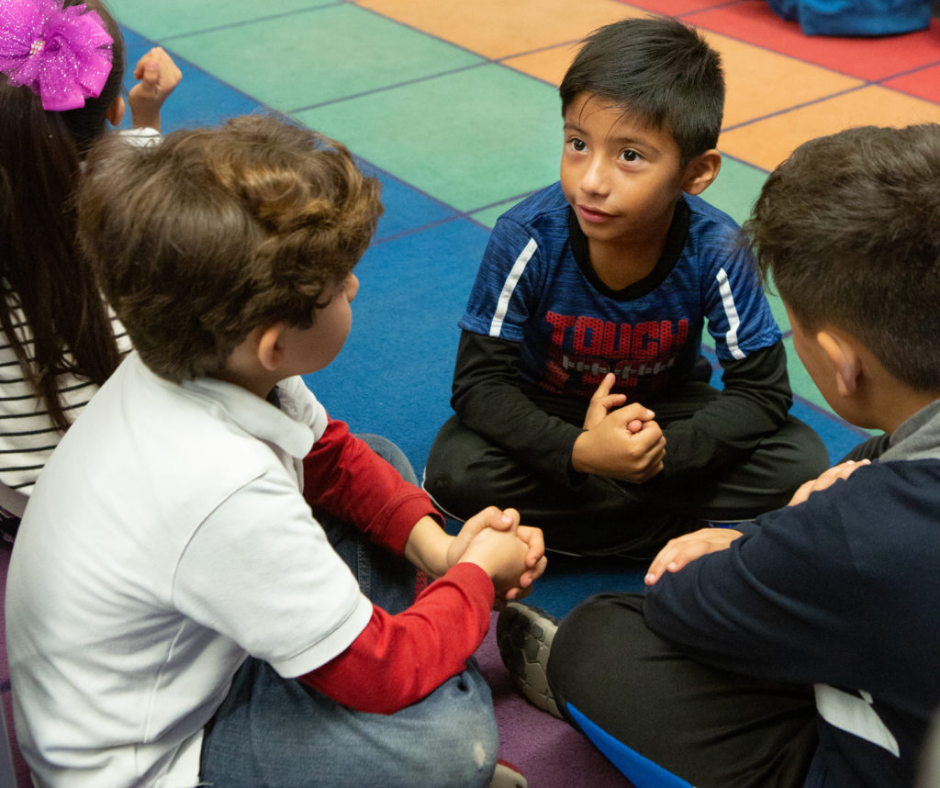What Is Co-Regulation and What Does It Look Like in the Classroom?

Many in the educational system—students and educators alike—are dealing with high levels of stress. This can make what might otherwise be expected moments of challenge, conflict, and dysregulation even more difficult to handle. These moments are both a symptom of and a way to communicate that increased stress.
When we as educators are carrying the heavy load of our own stress, and feel frustrated, helpless, or even threatened (physically and emotionally) by student behaviors, it can feel like the only way to respond is punitively, or by becoming overly restrictive.
But there is another (and more effective) way to respond to these challenges—with co-regulatory and restorative practices.
A Different Approach to Classroom Management
In classrooms that are physically and emotionally safe spaces, students are empowered to be their best selves and do their best learning. We often talk about these skills as our classroom management chops—how well we stay “in control” of our classrooms.
While this looks different for every teacher and in every classroom, educators face the same challenges, including what to do when things seem “out of control.”
- How do we react when students don’t follow directions?
- What moves do we make when the class is noisy and unfocused?
- What do we do when getting through a lesson feels impossible?
While it might feel counterintuitive in the moment, the best way we can create classrooms conducive to learning is not to demand compliance, but to lean into attuned, responsive relationships that empower students to own their learning and be accountable to their community.
Responding effectively to conflict and challenging student behavior is paramount to creating a safe, belonging-filled environment where great learning happens. Taking a co-regulatory and restorative approach means responding to these instances in ways that set students up to navigate these predictable, developmental experiences—managing and expressing themselves, taking and asking for accountability, and getting the support they need.
Co-regulatory and restorative practices empower both individuals and the school community to address root causes (rather than just the symptoms) of issues while building and maintaining trust and relationships.
What Is Co-Regulation and What Does it Look Like in the Classroom?
Co-regulation is the interactive process of regulatory support between a caring adult and a child. Unlike self-regulation, this requires adults to actively provide the environment and the scaffolds for a child to successfully meet their needs and achieve their goals.
This type of support begins in infancy, when adults are responsible for regulating most everything for that child—their patterns of eating and sleeping, their mood and emotions, etc. Co-regulation can be seen on a physical level, as infants’ heart rates and breathing sync up with their caregivers during times of co-regulatory support.
As children grow and develop skills, co-regulation looks different, but is still incredibly important.
Co-regulating practices in the classroom set up students of all ages to develop and practice self-regulation. This can look like:
- Being highly attuned and responsive to students’ holistic needs – proactively and in the moment
- Providing scaffolds for things like attention, emotion management, and executive functions
- Modeling and matching the type of engagement and energy required for students to participate in the learning and meet their goals
- Keeping students physically and emotionally safe, which turns down the “fight, flight, or freeze” brain and allows the “open, engaged, learning” brain
To set students up to be engaged and productive learners, educators have to understand the difference between striving for control vs. co-regulation.
When things are challenging, educators might be tempted to fall back on compliance-driven classroom management, because it feels like the only way to regain control over the situation. The consequences of striving for compliance are clear: Students are not given autonomy and ownership over their classroom community, they are not developing their own self-regulation skills, and trust and relationships are often damaged.
Instead, co-regulating practices provide predictable and consistent structure students can rely on, with adults who are attuned and responsive to students’ needs in the moment, and models and matches the level of engagement and energy required for students to meet their goals.
Strategies for Creating a Co-regulating Classroom
Educators can hone their co-regulatory supports for students by identifying their own “temperature boosters,” reflecting on challenging student interactions, and planning to incorporate co-regulating moves into their practice.

Here are some co-regulation moves that educators can implement in their classroom.
- Set the scene: Adjust the physical, auditory and visual classroom environment to work for students’ regulation
- Example: Using lighting as a cue—dimmer to bring the energy down, brighter to bring the energy up
- Match volume and tone: Use volume and tone to model how students should engage
- Example: When a situation is escalating, keeping a quiet or moderate volume with a serious, calm, steady tone
- Check your physical presence: Pay attention to how your physical presence, including body language, proximity and eye contact, affects students
- Example: Getting on students’ eye level to balance power
- Use reflecting language: Name and validate students’ experience and emotions
- Example: Naming the emotions students express as a way to show you are listening to or seeing them
- Prompt strategies and choices: Support students’ use of skills in the moment, while giving autonomy
- Example: Remind students of available supports or strategies, when they might not be at their best
Discover more examples of co-regulation strategies in the Co-Regulating Cues Workbook.

Share This Story